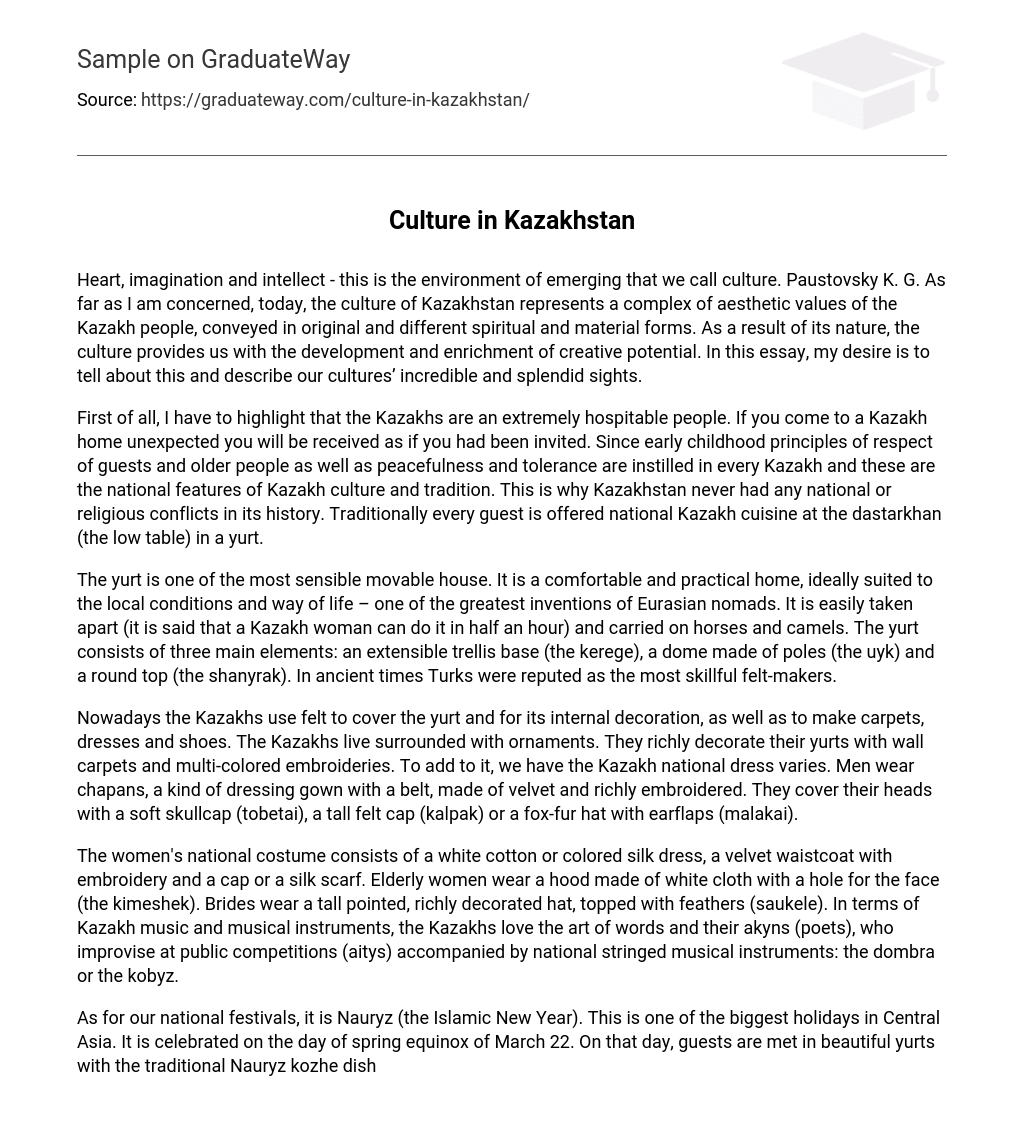Heart, imagination and intellect – this is the environment of emerging that we call culture.
Paustovsky K. G. believes that the culture of Kazakhstan today consists of a variety of aesthetic values of the Kazakh people, expressed in unique spiritual and material forms.
Due to its inherent nature, this culture allows for the growth and enhancement of creative potential.
In this essay, I aim to describe the remarkable and magnificent sights of our culture.
First and foremost, it must be emphasized that the Kazakhs are highly hospitable individuals. If one were to arrive unannounced at a Kazakh household, they would be received as if they were invited. From a young age, Kazakhs are taught the values of respecting guests, elders, and fostering a sense of peace and tolerance. These qualities are deeply rooted in Kazakh culture and tradition, which is why Kazakhstan has never experienced any national or religious conflicts throughout its history. A longstanding tradition involves welcoming every guest by offering them traditional Kazakh cuisine at a dastarkhan, a low table typically found in a yurt.
The yurt, a movable house, is considered one of the most sensible choices due to its comfort and practicality. It is designed to suit local conditions and way of life, making it a significant invention by Eurasian nomads. Remarkably, it can be easily dismantled, with claims that a Kazakh woman can do so in just half an hour. It is then transported on horses and camels. Comprised of three main components—the extensible trellis base known as the kerege, a dome made of poles called the uyk, and a round top known as the shanyrak—the yurt represents an architectural marvel. Furthermore, ancient Turks were renowned for their exceptional skills in felting.
Currently, the Kazakhs embrace felt for various purposes such as covering yurts, internal decoration, carpet making, dress creation, and shoe production. Kazakhs live amidst a plethora of ornaments, embellishing their yurts with wall carpets and vibrant embroideries. Additionally, the Kazakh national dress showcases diversity. Men don chapans, which are embroidered dressing gowns with velvet material and a belt. They adorn their heads with either a soft skullcap (tobetai), a tall felt cap (kalpak), or a fox-fur hat with earflaps (malakai).
The traditional attire for women in Kazakhstan includes a white cotton or colored silk dress, a velvet waistcoat with embroidered details, and a cap or silk scarf. Older women also wear a white cloth hood with a hole for the face, known as the kimeshek. On their wedding day, brides wear a tall pointed hat adorned with feathers called the saukele. Kazakh music is deeply loved and appreciated, with a special focus on the art of words and improvisation. During public competitions known as aitys, poets called akyns showcase their skills while being accompanied by national stringed musical instruments such as the dombra or kobyz.
One of the biggest holidays in Central Asia is Nauryz, which celebrates the Islamic New Year. Held on March 22, this day marks the spring equinox. During this festive occasion, guests are welcomed in splendid yurts and served Nauryz kozhe, a dish made from seven traditional ingredients. This nearly month-long holiday is a time for people to forgive each other’s debts and offenses. Additionally, Kazakhs participate in national games during this and other festivals.
These activities are usually performed on horse-back and provide an opportunity to witness the impressive riding skills of the Kazakh people. These activities include Kazakh wrestling, baiga (horse racing), kokpar (a unique polo game played with a dead goat), kyz-kuu (a game of catching the girl), and alty bakan (a six-pole swing), among others. Considering everything, personally, I believe that Kazakh culture has the potential to offer a variety of benefits. This is why it is important for Kazakh descendants to uphold it throughout their lives, treat it with respect and gratitude, and above all, take pride in it.





